新视野大学英语读写3(第三版)教案
新视野大学英语(第三版)读写教程Book3-Unit1-Section A-Never, ever give up!
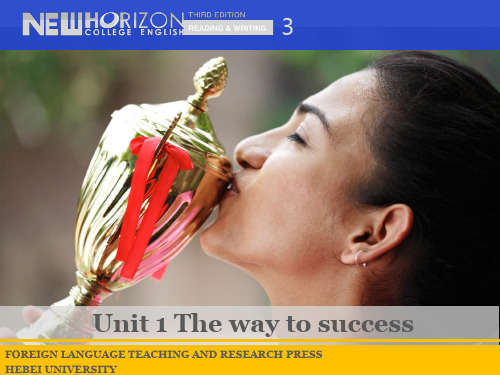
Section A Never, ever give up!
Project of the unit Inspiring your thoughts Enhancing your skills Presenting your project
3
Project of the unit
Project forecasting
Inspiring your thoughts
Global understanding
Inspiring your thoughts
Task 1 Global understanding of the introduction
Read Paras. 1-2 and answer the following questions. • What is the main idea of this part? It introduces the theme question of the text: What is the secret of success? Whose example is used to elicit the idea? The example of Winston Churchill.
•
Inspiring your thoughts
Task 2 Global understanding of the body (Paras. 3-7)
Step 1 Read Paras.3-7 and find out who are cited as examples to illustrate the secret of success. Work in groups of four. Present your answers to the other group members. Discuss what traits these people have in common to be successful.
新视野大学英语读写3(第三版)优秀教案

新视野大学英语读写教程(第三版)BOOK 3 教案章节 Unit One: The Way to SuccessSection A: New Words and Expressions 教案内容T ext: Never, ever give up! Exercises: Vocabulary, Sentence Structure, Translation Listening, Speaking & Writing Skills1.To talk about the secret of succes 。
s教案目的2. To further understand the tex 。
t3. To apply the phrases and pattern 。
s4. To master the essay writing skill。
1. Clearly know the structure of the passag 。
e教案要求2. Master the important language point 。
s3. Briefly summarize the passage alon 。
e4. Correctly use and master the key words in this unit.1. The structure of the whole passagediscussedand the writing ways重点m entioned in this passage2. The reading skills mentioned in this unit3. listening practicing related to the contents learned in this unit 1. The use of the new words and phrases in this passage难点2. The writing ways mentioned in this passage3. Some important sentence structures课堂设 计The First TwoPeriodsStep 1: Lead-in 10mStep 2:Pre-readingActivities 10mStep 3: NewWords80mQ uestioning & Discussing Questioning &DiscussingLecturing,Questioning &Questioning &DiscussingLecturing,Questioning&Dis Lec Que & Giv ExaThe Second Step 1:BackgroundInformation10mQ uestioning &DiscussingTwo Step 2: Structure Analysis 10m LecturingPeriodsStep 3: Language points and Difficult Sentences 70mLecturing,Questioning &Giving Examples2 / 45Step 4: Comprehension of the Text A 10m Q uestioning & DiscussingThe Third Two Periods Step 1: Summarize the passage orally 20mStep 2: Exercises (Words in use, Wordbuilding, Banked cloze, Expressions in use,70mTranslation in Section A)Step 3: Revision & Homework 10mQ uestioning &DiscussingQuestioning &DiscussingLecturing,QuestioningStep 1: Check Homework 30m QuestioningThe Forth Step 2:Structured Writing 30mW atching &DiscussingTwo Periods Step 3: Listening 20mL istening &Questioning Step 4: Speaking 20mQ uestioning &Discussing 教学过程The First Two Periods:Step 1: Lead-in:1. What is success?2. What do you think are the secrets of success?Step 2: Pre-reading Activities:1. Listen to a talk about steps to make your dreams come true. Fill in the blanksbased on what you hear.2. Listen to the talk again and discuss the following questions.Step 3: New WordsThe Second Two Periods:Step 1: Background Information1. Public schools in the UK & US2. Winston ChurchillStep 2: Structure AnalysisPart I (Paras.1-2): By using Winston Churchill ’s story and his speech at Harrow as an introduction to the topic, the text makes clear its statement:the secret of success is “Never give up ”.Part II (Paras.3-7): Through the examples of world famous scientists, statesman, andjurist, the text brings forward the statement that only those with astrong will , those who “keep their eyes on the prize ”, and thosewho expend the substantial effort to keep going, will finally succeed.Part III (Paras 8): By reinforcing the statement given in part II, the text draws theconclusion that with hard work, determination, dedication andpreparation, you can transcend any handicap, accomplish any feat,and achieve success.Step 3: Language points and Difficult SentencesPractical Phrases1. deviate from ⋯偏离,背离⋯⋯2. preclude sb. from doing 阻止某⋯人做⋯⋯3. triumph over 战胜⋯⋯⋯4. in (the) pursuit of 追⋯求⋯⋯5. work one ’s。
新视野大学英语读写教程3(第三版)Unit1_教案
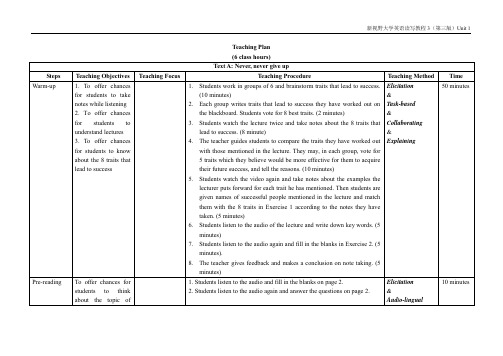
Teaching Focus
Teaching Plan (6 class hours) Text A: Never, never give up
Teaching Procedure 1. Students work in groups of 6 and brainstorm traits that lead to success.
Text B: Chance favors the prepared 1. The teacher inspires students and explains the ways to understand
denotation and connotation 2. Students practice the reading skill by reading Text B
underline a maximum of six words or phrases they don’t understand. Once chosen students show their words/phrases to their partner to see whether they can help in guessing meanings out. Finally, they are allowed to look up their words in the dictionaries and record both the words and the meanings. 2)Exercises: Language focus 3)Quiz: old to new 1. The teacher checks the writing work of students before giving feedback 2. The teacher concludes and provides feedback in general 3. Students check by themselves according to the feedback and make self-evaluation 4. Students check works of their peers according to the feedback and make evaluation
新视野大学英语读写3(第三版)优秀教案

新视野大学英语读写教程(第三版)BOOK 3 教案章节Unit One: The Way to SuccessSection A: New Words and Expressions教案内容Text: Never, ever give up!Exercises: Vocabulary, Sentence Structure,Translation Listening, Speaking & Writing Skills教案目的1.To talk about the secret of success。
2. To further understand the text。
3.To apply the phrases and patterns。
4.To master the essay writing skill。
1. Clearly know the structure of the passage。
2. Master the important language points。
教案要求3.Briefly summarize the passage alone。
4.Correctly use and master the key words in this unit.重点难点1.The structure of the whole passagediscussed and the writing waysmentioned in this passage2.The reading skills mentioned in this unit3.listening practicing related to the contents learned in this unit1.The use of the new words and phrases in this passage2.The writing ways mentioned in this passage3.Some important sentence structures课堂设计Step 1: Lead-in10m Questioning&The Discussing Questioning&First Step 2: Pre-reading Activities10m DiscussingTwoLecturing,PeriodsStep 3: New Words80m Questioning&Giving Examples The Step 1: Background Information10m Questioning& Second DiscussingTwo Step 2: Structure Analysis10m LecturingPeriodsLecturing, Step 3: Language points and Difficult70m Questioning&SentencesGiving ExamplesStep 4: Comprehension of the Text A10m Questioning&DiscussingStep 1: Summarize the passage orally20m Questioning& DiscussingTheStep 2:Exercises (Words in use, WordThird Questioning& building,Banked cloze, Expressions in use,70mTwoTranslation in Section A)DiscussingPeriodsLecturing, Step 3: Revision & Homework10m QuestioningStep 1: Check Homework30m QuestioningTheStep 2:Structured Writing30m Watching &Forth DiscussingTwoStep 3: Listening20m Listening &Periods QuestioningStep 4: Speaking20m Questioning & Discussing教学过程The First Two Periods:Step 1: Lead-in:1.What is success?2.What do you think are the secrets of success?Step 2: Pre-reading Activities:1. Listen to a talk about steps to make your dreams come true. Fill in the blanksbased on what you hear.2. Listen to the talk again and discuss the following questions.Step 3: New WordsThe Second Two Periods:Step 1: Background Information1. Public schools in the UK & US2. Winston ChurchillStep 2: Structure AnalysisPart I (Paras.1-2): By using Winston Churchill’ s story and his speech at Harrow as anintroduction to the topic, the text makes clear its statement: thesecret of success is“ Never give up”.Part II (Paras.3-7): Through the examples of world famous scientists, statesman, andjurist, the text brings forward the statement that only those with astrong will , those who“ keep their eyes on the prize” , and those whoexpend the substantial effort to keep going, will finally succeed.Part III (Paras 8): By reinforcing the statement given in part II, the text draws theconclusion that with hard work, determination, dedication andpreparation, you can transcend any handicap, accomplish any feat,and achieve success.Step 3: Language points and Difficult SentencesPractical Phrases1. deviate from ⋯偏离,背离⋯⋯2. preclude sb. from doing阻止某⋯人做⋯⋯3. triumph over战胜⋯⋯⋯4. in (the) pursuit of追⋯求⋯⋯5. work one’ s 。
新视野大学英语第三版读写教程Book 3--Unit 5 When work is a pleasure电子教案
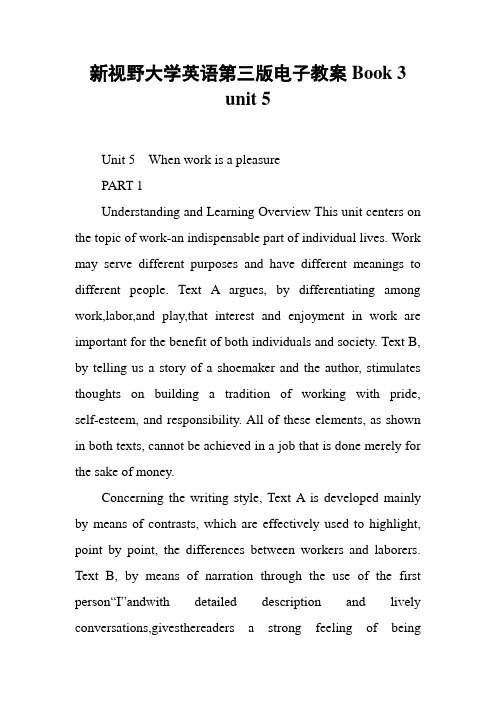
新视野大学英语第三版电子教案Book 3unit 5Unit 5 When work is a pleasurePART 1Understanding and Learning Overview This unit centers on the topic of work-an indispensable part of individual lives. Work may serve different purposes and have different meanings to different people. Text A argues, by differentiating among work,labor,and play,that interest and enjoyment in work are important for the benefit of both individuals and society. Text B, by telling us a story of a shoemaker and the author, stimulates thoughts on building a tradition of working with pride, self-esteem, and responsibility. All of these elements, as shown in both texts, cannot be achieved in a job that is done merely for the sake of money.Concerning the writing style, Text A is developed mainly by means of contrasts, which are effectively used to highlight, point by point, the differences between workers and laborers. Text B, by means of narration through the use of the first person“I”andwith detailed description and lively conversations,givesthereaders a strong feeling of beingpersonally on the scene,and achieves the effect of great vividness.In order for students to get a strong understanding ofthe unit theme and foster a good attitude toward work,the teacher should encourage thought-provoking discussions and activities. The topics for the discussions may includewhy we work, how we can foster love for work, how we achieve happiness at work, are peer interviews,retellingof Text B, questionnaire survey to gauge thehappiness level of a specific occupation and towork out how to achieve greater happiness at work.Section A Will you be a worker or a laborBackground information1 continuing educationContinuing education refers to the education for adults, usually in classes that are held in the evening and especially on subjects that are related to their jobs.2 experiential learningExperiential learning is the process of making meaning from direct experience. It is learning through reflection on doing, which is often contrasted with rote learning (死记硬背). Experiential learning focuses on the learning process for the individua1. An1example of experiential learning is going to the zoo and learning through observation and interaction with the zoo environment, as opposed to reading about animals from a book. Thus, one makes discoveries and experiments with knowledge firsthand, instead of hearing or reading about others’ experiences.Detailed study of the text1 In a society where slavery in the strict sense has been abolished, the socialindications around work,the value of work and the salary, have degraded many laborers into modern slaves-“wage slaves”.(Para. 1)Meaning: In a society where slavery, strictly speaking, has been put to an end, the social status of work, the value of work and the salary, have made many laborersbexxe modern slaves-“wage slaves”.★degrade:vt. treat sb. without respect and make them lose respect for themselves贬低(某人);羞辱(某人)The examination supervisor warned students not to degrade themselves by cheating on the exam.监考老师警告学生不要在考试中舞弊,以免自取其辱。
新视野大学英语读写教程第三册Unit_7_Section_A教案(转载)
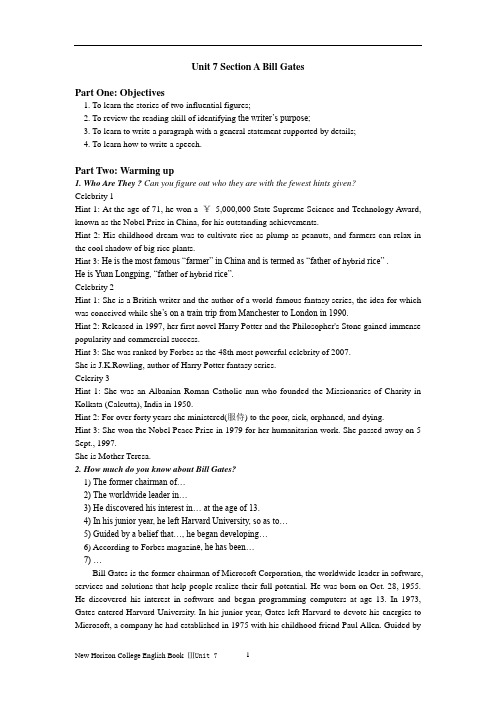
Unit 7 Section A Bill GatesPart One: Objectives1. To learn the stories of two influential figures;2. To review the reading skill of identifying the writer’s purpose;3. To learn to write a paragraph with a general statement supported by details;4. To learn how to write a speech.Part Two: Warming up1. Who Are They ? Can you figure out who they are with the fewest hints given?Celebrity 1Hint 1: At the age of 71, he won a ¥5,000,000 State Supreme Science and Technology Award, known as the Nobel Prize in China, for his outstanding achievements.Hint 2: His childhood dream was to cultivate rice as plump as peanuts, and farmers can relax in the cool shadow of big rice plants.Hint 3: He is the most famous “farmer” in China and is termed as “father of hybrid rice” .He is Yuan Longping, “father of hybrid rice”.Celebrity 2Hint 1: She is a British writer and the author of a world-famous fantasy series, the idea for which was conceived while she’s on a train trip from Manchester to London in 1990.Hint 2: Released in 1997, her first novel Harry Potter and the Philosopher's Stone gained immense popularity and commercial success.Hint 3: She was ranked by Forbes as the 48th most powerful celebrity of 2007.She is J.K.Rowling, author of Harry Potter fantasy series.Celerity 3Hint 1: She was an Albanian Roman Catholic nun who founded the Missionaries of Charity in Kolkata (Calcutta), India in 1950.Hint 2: For over forty years she ministered(服侍) to the poor, sick, orphaned, and dying.Hint 3: She won the Nobel Peace Prize in 1979 for her humanitarian work. She passed away on 5 Sept., 1997.She is Mother Teresa.2. How much do you know about Bill Gates?1) The former chairman of…2) The worldwide leader in…3) He discovered his interest in… at the age of 13.4) In his junior year, he left Harvard University, so as to…5) Guided by a belief that…, he began developing…6) According to Forbes magazin e, he has been…7) …Bill Gates is the former chairman of Microsoft Corporation, the worldwide leader in software, services and solutions that help people realize their full potential. He was born on Oct. 28, 1955. He discovered his interest in software and began programming computers at age 13. In 1973, Gates entered Harvard University. In his junior year, Gates left Harvard to devote his energies to Microsoft, a company he had established in 1975 with his childhood friend Paul Allen. Guided bya belief that the computer would be a valuable tool on every office desktop and in every home, they began developing software for personal computers. Under Gates' leadership, Microsoft's mission has been to continually advance and improve software technology, and to make it easier and more enjoyable for people to use computers. According to Forbes magazine, Gates has been the richest man in the world since 1995.3. What challenges did Bill Gates meet? And what do you think of that?1) The federal government claimed that …2) This case started when …3) Although Microsoft believed it’s logical, its competitors thought that …4) As far as the case is concerned, I think that …Our top story today is the case being brought against Microsoft by the federal government, accusing the software giant of unfair business practices. It claims the company is keeping a firm grip on the world’s operating system market to squeeze out the competition in other software application areas such as Internet software. Microsoft claims that it is only logical for its company to want to bundle and distribute its software with its operating systems, while its competitors claim that other companies’Internet software deserves equal access to Microsoft’s operating systems. They say that if Microsoft’s operating systems are shipped with its software included, the software of other companies should be included as well.The federal government claims that Microsoft practices unfair business practices, namely, monopoly power to gain advantage over its competitors. This case started when Microsoft bundled its Windows 95 operating system with its Internet Explorer software. Although Microsoft believes it’s logical for its company to bundle and distribute its software with its operating systems, its competitors hold their Internet software deserves equal access to Microsoft’s operating systems as Microsoft’s.As far as the case is concerned, however, I think there is no point arguing about who is right or wrong, but the point is to ponder over why Bill Gates’success is the focus of public attention.4. What contributes to Bill Gates’huge success?1) His keen insights into…2) His total commitment to…3) His great skills in managing…4) His competitive ability in…5) …In the first place, it is a return from his keen insights into his future. As he once put it, “At 19, I caught sight of the future …and I turned out to have been right.”In the second, it is a fruit of his total commitment to his pursuits. For example, it was not unusual for the dean of Microsoft to work16 hours a day. In the third, it is a product of his great skills in managing his business. According to his colleagues, he could deal efficiently with technical problems while handling routine affairs. And above all, it is a result of his competitive ability in development of sophisticated IT products. In more than 30 years since he dropped out of Harvard to conquer the world of computer operating systems and application software, in effect, he has been deadly for competitors trying to claw their way into the market.5. From Bill Gates’dropout of Harvard, can we tell that college education means nothing to one’s success?My answer to this question is negative. Because his experience on Harvard campus, though unable to produce a direct effect on his success, helped keep his mind open to what was going on in the world of science and render him sharper at what future would hold for him. According to Bill Gates, his experience in Harvard was regarded as “an amazing privilege”. He once said, “ThoughI left early, I was transformed by my years at Harvard, the friendships I made, and the ideas I worked on.”In fact, he learned a lot at Harvard about new ideas in economics and politics. And he got great exposure to the advances being made in the sciences. So actually, the years in Harvard contributed a lot to his future success.6. From his life, what conclusion can we draw as to the relationship between college degree and success?It is widely believed that, the higher degree one earns, the better chance of success one stands. But Bill Gates’case tells a different story. From his experience, therefore, we can conclude that the college degree is not a guarantee of one’s success in career but a symbol of one’s complete experience with college life or at most a witness to a person’s buildup of knowledge essential to his success in career. As is known to all, Bill Gates didn't finish his bachelor’s degree and dropped out of Harvard, let alone the master’s or doctor’s degree. However, he founded the biggest software company in the world—Microsoft Corporation and with more than fifty billion dollars wealth he has been the richest man in the world, for all of which, however, he didn't depend on his educational diploma! Thus it can be seen that one’s success is built not on the college degree but on his ability bettered by the college life.7. What does the author want to tell us about Bill Gates?Let’s answer this question after we read the passagePart Three: Related Information1. Role modelThe term role model was introduced by Robert K. Merton. Merton says that individuals compare themselves with "reference groups" of people who occupy the social role to which the individual aspires. The term has passed into general use to mean any "person who serves as an example, whose behavior is emulated by others".(1) Robert King MertonRobert King Merton (July 4, 1910 –February 23, 2003) was a distinguished American sociologist perhaps best known for having coined the phrase "self-fulfilling prophecy". He also coined many other phrases that have gone into everyday use, such as "role model" and "unintended consequences". He spent most of his career teaching at Columbia University.(2) Albert EinsteinAlbert Einstein (March 14, 1879 –April 18, 1955) was a German-born theoretical physicist. He is best known for his theory of relativity and specifically mass–energy equivalence, E = mc2. Einstein received the 1921 Nobel Prize in Physics “for his services to Theoretical Physics, and especially for his discovery of the law of the photoelectric effect (光电效应).”Einstein published over 300 scientific works and over 150 non-scientific works. Einstein is revered by the physics community, and in 1999 Time magazine named him the "Person of the Century". In wider culture the name "Einstein" has become synonymous with genius.(3) Mohandas Karamchand GandhiMohandas Karamchand Gandhi (2 October 1869 –30 January 1948) was a major political and spiritual leader of India and the Indian independence movement. He was the pioneer of Satyagraha—resistance to tyranny (暴政) through mass civil disobedience (非暴力反抗) —which led India to independence and inspired movements for civil rights and freedom across the world. In India, he is officially accorded the honor of Father of the Nation. On 15 June 2007, the United Nations General Assembly declared 2 October to be the "International Day of Non-Violence".I want world sympathy in this battle of Right–against–Might. By Gandhi April 5, 1930(4) Mother TeresaMother Teresa (August 26, 1910 –September 5, 1997) was an Albanian Roman Catholic nun who founded the Missionaries of Charity in Kolkata (Calcutta), India in 1950. For over forty years she ministered to the poor, sick, orphaned, and dying, while guiding the Missionaries of Charity's expansion, first throughout India and then in other countries. She won the Nobel Peace Prize in 1979 for her humanitarian work.(5) Bill GatesBorn October 28, 1955, Bill Gates is an American business magnate, philanthropist, and chairman of Microsoft. During his career at Microsoft, Gates held the positions of CEO and chief software architect, and remains the individual shareholder with the most shares, with more than 9 percent of the common stock (普通股).(6) Martin Luther King, Jr.Martin Luther King, Jr. (January 15, 1929 –April 4, 1968) was one of the pivotal leaders of the American civil rights movement. King was a Baptist minister, one of the few leadership roles available to black men at the time. He became a civil rights activist early in his career. His efforts led to the 1963 March on Washington, where King delivered his “I Have a Dream”speech. In 1964, King became the youngest person to receive the Nobel Peace Prize for his efforts to end segregation and racial discrimination through civil disobedience and other non-violent means.King was assassinated on April 4, 1968, in Memphis, Tennessee. Martin Luther King, Jr. Day was established as a national holiday in the United States in 1986.(7) Jack St. Clair Kilby(November 8, 1923-June 20, 2005) is a Nobel Prize laureate in physics in 2000 for his invention of the integrated circuit in 1958 while working at Texas Instruments (TI). He is also the inventor of the handheld calculator and thermal printer (感热式打印机)2. Microsoft:Microsoft is a company founded by Bill Gates together with his childhood friend Paul Allen in 1975. In the late 1970s a number of individuals and companies were making and distributing home computers. Nobody can honestly say that they predicted back then just how pervasive home computers would become. IBM noticed this phenomenon, and saw it as a way of impressing upon small business just how plain good IBM machines are. IBM did a deal with Microsoft, a small company then, to produce the operating system for their PC. Like many other companies who were unable to predict the huge growth of the PC market, IBM didn’t pay too much attention to the details of the deal. IBM could distribute DOS with their PCs, paying Microsoft a royalty for every copy sold. Microsoft, however, could also sell DOS independently of IBM. The deal withIBM for the distribution of DOS was probably the smartest thing Microsoft has ever done. It was the first of Microsoft’s many successes.3. Paul Allen:At Lakeside School, Paul Allen (14 years old) and friend Bill Gates (12 years old) became early computer enthusiasts. Allen went on to attend Washington State University, though he dropped out after two years to pursue his and Gates’dream of writing software commercially for the new “personal computers”.4. MITS Altair:The MITS Altair microcomputer was the first personal computer available and sold in commercial quantities. MITS originally stood for Micro Instrumentation and Telemetry Systems (微仪表和自动系统公司) but this name was almost never used after 1975. Later, MITS became a subsidiary of Pertec Computer Corp.5. Apple:Apple is a computer company started on April 1, 1976. Steven Wozniak, a high school drop-out who worked for Hewlett-Packard, dabbled in computer-design and created what would become the Apple I. His high school buddy Steven Jobs, also a drop-out, worked for Atari and convinced him that the two should form a company to market the new computer, which eventually took off in 1977 with the Apple II.6. Commodore:Commodore Business Machines, Ltd. (柯摩多尔商务机器有限公司) was founded in 1954 by Jack Tramiel as a typewriter repair shop. After some time in the typewriter, adding machine, and hand-held calculator markets, Commodore became first company to announce that it was producing a consumer-friendly home computer (the PET 2001). Before they filed bankruptcy in 1994, Commodore had also managed to produce the world’s first multi-media computer ( the Amiga), and what is still today the best selling computer model of all time (the Commodore 64).7. Tandy:Tandy Corporation (坦迪公司), now known as Radio Shack, is a large manufacturer of electronics and computer accessories and equipment that first entered the electronic market when opening its first Radio Shack in 1921. Today several thousand Radio Shacks are throughout the United States as well as other computer stores such as Computer City. Tandy at this time no longer manufactures computers but is still a large contributor in the computer industry and electronic industry.8. IBMIBM is the best known American computer manufacturer, founded by Thomas J. Watson known as “Big Blue”after the color of its logo. IBM stands for International Business Machines (国际商用机器公司), the largest computer company in the world today. It makes everything from mainframes to personal computers (PCs) and has been immensely successful in selling them, chiefly to business.9. DreamWorks SKG:Steven Spielberg, Jeffrey Katzenberg and David Geffen launched DreamWorks SKG (initials of its founders) in October 1994. Their vision was to create an artist-friendly studio to develop, produce and distribute superior film and music entertainment that would inspire and delight audiences worldwide. DreamWorks SKG is now a leading producer of live-action motion pictures, animated feature films, network, and cable television programming, home video and DVDentertainment and consumer products.Part Four: Text UnderstandingI. Idea CatchingThe Birth of the TextFactor I: There has been an ever-greater curiosity about how Bill Gates’legend came true. Factor II: People wonder what traits in him have led to his success.Factor III: People wonder what challenges he met in his life like others.Author: The author wants to tell others his insight into Bill Gates’life.Personal developmentIn 1975: ⑺Gates and Paul Allen wrote an interpreter for the programming language used by MITS Altair.In 1976: ⑻Gates began licensing Microsoft’s software products directly to computer manufacturers.In 1980: ⑼IBM invited Microsoft to write programming languages for IBM PC.In 1981: ⑽The IBM PC and MS-DOS were bundled together and announced to the public.By 1995: ⑾Roughly 85% of the world’s personal computers were using a Microsoft operating system.In 1997: ⑿Gates was worth an estimated $40 billion.II. Structure Analysis1.What is the text mainly about?2.How is the text organized?This passage is a third-person narrative about the richest businessman in the world—Bill Gates. The whole passage is organized according to “General introduction — Detailed illustrations —Conclusion” pattern. Since the key idea is illustrated from two perspectives, the passage naturally falls into four partsPart I Introduction (Para.1) Main idea: Bill Gates has dominated the personal computing revolution and modernized the whole world in the process. Without a doubt, Bill Gates is one of the greatest minds to ever change the world. (the richest businessman in the world, Bill Gates. )Devices for developing it: Comparison: (Refer to Para. 1) The author compares Bill Gates with Thomas Edison, Alexander Graham Bell, and other great minds who ever changed the world.Part II Illustration I (Para. 2-6) Main idea:What adds to Gates’ big success includes his personal traits: his personality — a blend of high-voltage brilliance, drive and competitiveness; his time management skills; his sense of saving money and time in traveling; his incredible “multitasking” ability; and his managing style.(Bill Gates’personal traits resulting in his success )Devices for developing it: General—particular details:This part is typical of the device—from a general statement to particular details. (Refer to Paras. 2, 3, 4, 5, 6)Part III Illustration II (Paras. 7-11) Main idea: Bill Gates’personal development also outlines his steady road to success—In 1975, Gates, together with Allen, laid the first brick in the foundation of Microsoft; In 1976, he began licensing Microsoft’s software products; In 1980s and 1990s, Microsoft quickly dominated the world market; and today the Microsoft “campus”is a home for new ideas and products. (Bill Gates’personal development)Devices for developing it: Time sequence: Time markers and episodes:At his sixth grade (Para. 7): Seeing a psychologist to reveal his personalityAt the age of 19 (Para. 8): Writing the computer programming languageIn 1976 (Para. 9): Licensing Microsoft’s software productsIn 1980s and 1990s (Para. 10): Dominating the world software marketToday (Para. 11): Microsoft campus, a home for new ideasPart IV Conclusion Main idea: As the conclusion of the passage, Gates hopes to be running Microsoft for another 10 years and then he promises to focus on his family and giving his money away. But one can only wonder what he will do in the near future. (Gates’future plan )Devices for developing it: Induction: Known facts: 1) Gates hopes to run Microsoft for another 10 years; 2) Then he promises to focus on his family; 3) He also wants to give his money away.Conclusion: But no one knows what the great mind will do in the near future.Part Five: Notes To The Text☆New words and expressions1. to catch sight of 看到当城里的孩子在乡下看到一群鸭子走过时他们感到无比兴奋。
新视野大学英语3读写教程第三版ppt课件
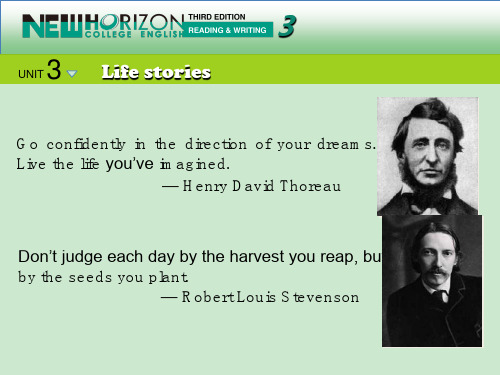
Pre-reading activities
Cultural background
从使用情况来看,闭胸式的使用比较 广泛。 敞开式 盾构之 中有挤 压式盾 构、全 部敞开 式盾构 ,但在 近些年 的城市 地下工 程施工 中已很 少使用 ,在此 不再说 明。
Lead-in
Matching up
3. How did Audrey Hepburn influence the world?
Tips
• She was universally reckoned to be the most beautiful woman and a style icon in the world. She still influences major stars of today and remains the fashion icon of the present world.
5 Steve Spielberg
2 Charlie Chaplin
A. Jurassic Park
(《侏罗纪公园》)
1 Audrey Hepburn
C. Roman Holiday
(《罗马假日》)
4 Zhang Yimou
D. The Great Dictator
(《大独裁者》)
3 Zhang Ziyi
从使用情况来看,闭胸式的使用比较 广泛。 敞开式 盾构之 中有挤 压式盾 构、全 部敞开 式盾构 ,但在 近些年 的城市 地下工 程施工 中已很 少使用 ,在此 不再说 明。
Pre-reading activities
Watch and talk
Watch the video about Audrey Hepburn, take down the key points and then make a presentation about her life story.
新视野大学英语第三版第三册Unit4教案

Unit 4 Section A The surprising purpose of travel令人惊奇的旅行目的1 It's 4:15 in the morning, and my alarm clock has just stolen away a lovely dream. I almost return back to sleep before my eye catches my packed suitcase and I groan, remembering that I'm going to the airport. The taxi is late and then lost, and I'm getting increasingly nervous that I'll miss my flight. I run in when we arrive, stagger through security and finally get to my gate. After all the trouble of this morning, my flight is canceled and I'm stuck in this terminal for the next 218 minutes, and my only consolation is a cup of complimentary airport coffee. This is traveling, a burdensome series of running and waiting, and after countless hours, finally getting there.1 早晨四点一刻,闹钟把我从美梦中惊醒,要不是突然看见早已收拾好的行李箱,我几乎又要睡着。
想起来还要去机场,我叹了口气。
新视野大学英语第三版读写教程B3U4SectionA课后练习答案PPT学习教案
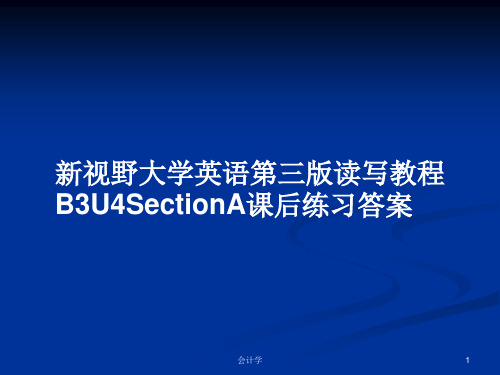
第2页/共32页
2. I am most interested in visiting the Terracotta Army in Xi'an. First, I believe it is the most famous tourist attraction that will jump into anyone's mind when one is visiting Xi'an. It is regarded as an admirable miracle of the world.
第6页/共32页
3. What kind of travel is truly compulsory? Only corporate travel, about 30% of trips over 50 miles, is truly
compulsory 4. How do you understand the phrase "Paris is Paris" in Paragraph 4? We go to Paris for the sake of its being Paris. We just want to
新视野大学英语读写教程(第三版)第三册讲义(Units 1-6)
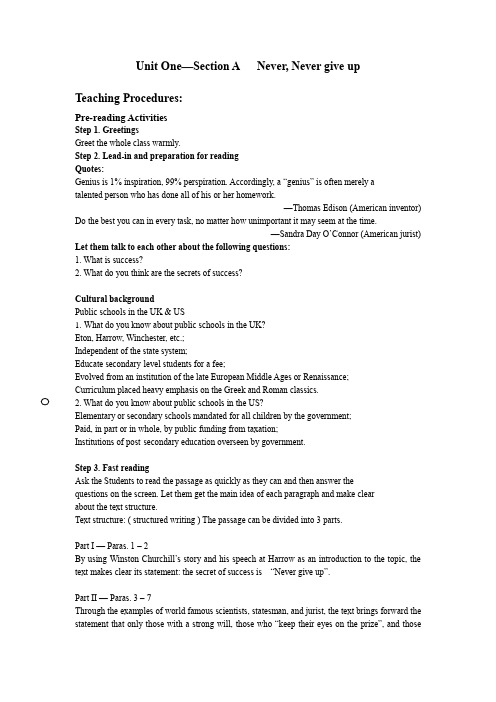
Unit One—Section A Never, Never give upTeaching Procedures:Pre-reading ActivitiesStep 1. GreetingsGreet the whole class warmly.Step 2. Lead-in and preparation for readingQuotes:Genius is 1% inspiration, 99% perspiration. Accordingly, a “genius” is often merely atalented person who has done all of his or her homework.—Thomas Edison (American inventor) Do the best you can in every task, no matter how unimportant it may seem at the time.—Sandra Day O’Connor (American jurist) Let them talk to each other about the following questions:1. What is success?2. What do you think are the secrets of success?Cultural backgroundPublic schools in the UK & US1.What do you know about public schools in the UK?Eton, Harrow, Winchester, etc.;Independent of the state system;Educate secondary-level students for a fee;Evolved from an institution of the late European Middle Ages or Renaissance;Curriculum placed heavy emphasis on the Greek and Roman classics.2. What do you know about public schools in the US?Elementary or secondary schools mandated for all children by the government;Paid, in part or in whole, by public funding from taxation;Institutions of post-secondary education overseen by government.Step 3. Fast readingAsk the Students to read the passage as quickly as they can and then answer thequestions on the screen. Let them get the main idea of each paragraph and make clearabout the text structure.Text structure: ( structured writing ) The passage can be divided into 3 parts.Part I — Paras. 1 – 2By using Winston Churchill’s story and his speech at Harrow as an introduction to the topic, the text makes clear its statement: the secret of success is “Never give up”.Part II — Paras. 3 – 7Through the examples of world famous scientists, statesman, and jurist, the text brings forward the statement that only those with a strong will, those who “keep their eyes on the prize”, and thosewho expend the substantial effort to keep going, will finally succeed.Part III — Para. 8By reinforcing the statement given in part II, the text draws the conclusion that with hard work, determination, dedication and preparation, you can transcend any handicap, accomplish any feat, and achieve success.Structure of the textPurpose : Improve the students’ reading and writing ability and understand the general idea of each paragraph.Method: Read the text individually and talk in groups; Use task-based language teaching method, reading approach, communicative approach and total physical response method.Step 4: While-reading ActivitiesStudents are required to look at the Words and Phrases on the screen and give a brief presentation in class.Words and Phrases:Purpose: Train the Students’ ability of understanding and using foreign language.Method:Talk in groups, Use task-based language teaching method, communicative approach and total physical response method.Practical phrases1.deviate from … 偏离,背离……有人生目标的人是永远不会偏离正确航向的。
新视野大学英语读写(第三版)Book3-Unit-4教案
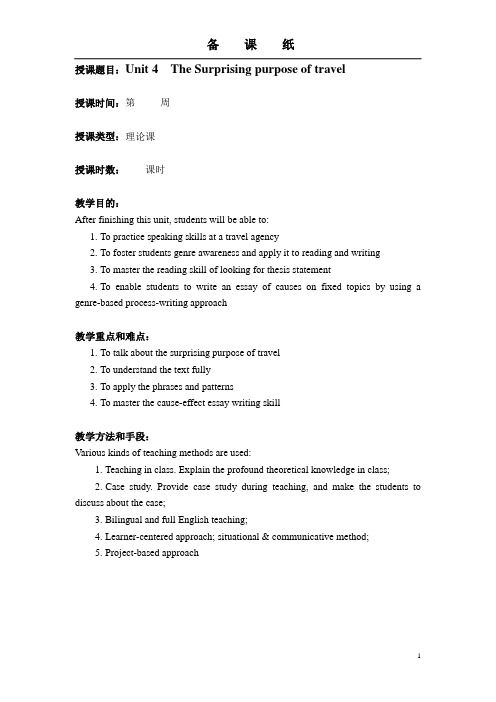
授课题目:Unit 4 The Surprising purpose of travel授课时间:第_____周授课类型:理论课授课时数:____课时教学目的:After finishing this unit, students will be able to:1.To practice speaking skills at a travel agency2.To foster students genre awareness and apply it to reading and writing3.To master the reading skill of looking for thesis statement4.To enable students to write an essay of causes on fixed topics by using a genre-based process-writing approach教学重点和难点:1.To talk about the surprising purpose of travel2.To understand the text fully3.To apply the phrases and patterns4.To master the cause-effect essay writing skill教学方法和手段:Various kinds of teaching methods are used:1.Teaching in class. Explain the profound theoretical knowledge in class;2.Case study. Provide case study during teaching, and make the students to discuss about the case;3.Bilingual and full English teaching;4.Learner-centered approach; situational & communicative method;5.Project-based approach教学内容和过程:Section A The surprising purpose of travelStep One Warming-up Activities 30 minutesI. Write as many words related to travel as you can•Varieties of travel•Means of transportation•Tourist attractions•Entertainment activities•Things to take•Where to stay•Other words about travelII. Lead-in questions:1.Do you like travelling? What are the reasons for you to travel?•To have a change•To experience something new and unfamiliar•To see the world and understand different culture•To marvel at the wonder of great nature•To escape from a boring lifestyle•To have a thorough relaxation•To broaden one’s horizons2.What’s your suggestion to a student who wants to have a trip but doesn’thave enough money for it?•Plan ahead•Find useful information•Travel in group•Go to a less-known place•Pack necessary thingsIII Background knowledge1.Where is Left Bank café? What features does it have?•The Left Bank café is located in the village of Saranac Lake on the Left Bank of the River Seine in Paris. It is a favorite meeting place of great artists, writers, and famous intellectuals since the early 20th century. LBC serves authentic French café-style food, including crêpes and tar tines, as well ascoffee, tea, wines and beers.2.What is Let’s Go? Give more information about it.• A world-renowned travel guide series, researched, written, edited, and run entirely by students at Harvard University.•It is claimed to be “the student travel guide” aimed at readers “both young and young at heart”.•Let’s Go was founded in 1960 and is headquartered in Cambridge, Massachusetts, the US. Office.3. What do you know about Machu Picchu?•An ancient ruined South American city high up in the Andes Mountains in Peru.•It was built by the Incas, a Native American people of South America, in about 1500 AD,•It has a temple of the sun and many other buildings.•It is a popular place for tourists to visit.Step Two Text Study 80 minutesI.Interactive reading of the text1. Reading comprehension1)Why does the author choose the word “burdensome” to describe hisimaginary travel? (Para. 1)2)What does the author mean by “the rest of the journey can feel like a tediousl esson in the ills of modernity? It sucks.”? (Para. 2)3)Suppose travel is troublesome and sometimes even unpleasant, why do wetravel according to the author? (Para. 2-4)4)What kind of travel is truly compulsory? (Para. 4)5)What is the irony when people travel to Paris trying to leave all thosetroubles behind? (Para. 5)6)What is the finding of the research? What does the author wants to prove byreferring to the example? (Para. 6)7)What do we need to do to trigger our creativity? (Para. 8)8)What are the secret cornerstones of creativity of travel?What will happen to usafter travel? (Para. 9)2. Structure of the textPart I Introduction (Paras. 1-4)The author gives us a vivid description of the imaginary travel experience, including how he struggles to get up in the early morning, how he gets to the flight gate after all trouble and how he finally gets stuck in the airport. The author puts forward a question: Why do we travel?Part II Body (Paras. 5-8)The author takes us to rethink the question: what is the real purpose of travel? Besides, she shares her own understanding of the real purpose of travel.Part III Concluding part (Para 9)We travel because we need to, because distance and difference are the secret cornerstones of creativity..3. Summary of the TextTravel is ___________ and sometimes even unpleasant; then what is the driving force behind our travel? We travel because we need to. Sometimes our travel is a ____ because we should attend the business luncheon, because we should celebrate Thanksgiving with our mom. We travel because we want to.Owing to the fact that most travel is _______, we just travel following our heart. Most people travel for the sake of __________, but their mind tends to solve the stubborn ___________ issues while on vacation. What is the real purpose of travel? Travelling to a new place can make us less controlled by familiar cognitive ________ that imprison us. As a result, we can better combine the new with the old, the mundane is ________ from a slightly more abstract perspective.To __________ travelers, multicultural contrast means that they are open to ambiguity and willing to see the world in different ways, thus to expand the ______________ of their “cognitive inputs” as they refuse to __________t heir first answers and initial guesses. Of course, that mental flexibility is a side effect of difference and we know what we did not know in the past, by which we become more open-minded and less _______.Apart from its advantages, travel also has it _________, which make us not take great pleasantness. More often than not, we need a _________ after our vacation. We travel because we need to, because distance and difference are the _____________of creativity. Travel will change our mind to some extent, which inturn can have ________on everything in our life.II. Language Focus: Words and expressions1. Key words:1)groan: (Para.1)vi. make a long low sound, e.g. because you are in pain or unhappy (因痛苦或烦恼等)呻吟,发出哼哼声The old man was groaning with pain.v. speak about sth. in a way that shows you are unhappy 抱怨She sat down beside me and groaned about her working day. 她坐在我身旁,抱怨自己整日辛劳。
新视野大学英语第三版读写教程Book 3--Unit 5 When work is a pleasure电子教案

新视野大学英语第三版电子教案Book 3unit 5Unit 5 When work is a pleasurePART 1Understanding and Learning Overview This unit centers on the topic of work-an indispensable part of individual lives. Work may serve different purposes and have different meanings to different people. Text A argues, by differentiating among work,labor,and play,that interest and enjoyment in work are important for the benefit of both individuals and society. Text B, by telling us a story of a shoemaker and the author, stimulates thoughts on building a tradition of working with pride, self-esteem, and responsibility. All of these elements, as shown in both texts, cannot be achieved in a job that is done merely for the sake of money.Concerning the writing style, Text A is developed mainly by means of contrasts, which are effectively used to highlight, point by point, the differences between workers and laborers. Text B, by means of narration through the use of the first person“I”andwith detailed description and lively conversations,givesthereaders a strong feeling of beingpersonally on the scene,and achieves the effect of great vividness.In order for students to get a strong understanding ofthe unit theme and foster a good attitude toward work,the teacher should encourage thought-provoking discussions and activities. The topics for the discussions may includewhy we work, how we can foster love for work, how we achieve happiness at work, are peer interviews,retellingof Text B, questionnaire survey to gauge thehappiness level of a specific occupation and towork out how to achieve greater happiness at work.Section A Will you be a worker or a laborBackground information1 continuing educationContinuing education refers to the education for adults, usually in classes that are held in the evening and especially on subjects that are related to their jobs.2 experiential learningExperiential learning is the process of making meaning from direct experience. It is learning through reflection on doing, which is often contrasted with rote learning (死记硬背). Experiential learning focuses on the learning process for the individua1. An1example of experiential learning is going to the zoo and learning through observation and interaction with the zoo environment, as opposed to reading about animals from a book. Thus, one makes discoveries and experiments with knowledge firsthand, instead of hearing or reading about others’ experiences.Detailed study of the text1 In a society where slavery in the strict sense has been abolished, the socialindications around work,the value of work and the salary, have degraded many laborers into modern slaves-“wage slaves”.(Para. 1)Meaning: In a society where slavery, strictly speaking, has been put to an end, the social status of work, the value of work and the salary, have made many laborersbexxe modern slaves-“wage slaves”.★degrade:vt. treat sb. without respect and make them lose respect for themselves贬低(某人);羞辱(某人)The examination supervisor warned students not to degrade themselves by cheating on the exam.监考老师警告学生不要在考试中舞弊,以免自取其辱。
新视野大学英语第三版读写教程Book3-Unit6-SectionA-War and peace

Project of the unit
Lead-in
Project forecasting
Project of the unit
Although war seems far away from our lives, it happens in the other corner of the world the very minute we study or play. War affects not only the officers and soldiers in the battlefield but also the common people who are in the rear area. By the end of this unit, you are expected to write a descriptive essay on the following topic: Please get prepared by doing the following activities.
Inspiring your thoughts
3) Why does the author write in detail his grandfather’s situation? Because the author wants to take his grandfather, a victim of war, as a typical example to reveal the helplessness of individuals in the cruel war.
Inspiring your thoughts
Detailed understanding
Inspiring your thoughts
大学英语Book3 unit1 教案

工业学院教案课程:大学英语(3)学期:20 —20 学年第一学期教师:工业学院教案Unit 1说写课(第1次课)The first 50 minutes:Step1: Term plan and pre-reading activities. (15 minutes)1.Introduce the term plan of learning English and some changes in teachingincluding how to grade English in this term.2.Talk about the topic “The way to success” and ask students how to define “success”.Do the pre-reading activities on page 2 (listening).Step 2: Text A reading comprehension.1.Ask the students to read Text A within 15 minutes and raise questions about textunderstanding.2.Discuss and find answers to questions on page 9: understanding the text andcritical thinking (for critical thinking questions, the teacher had better ask the students to choose only one or two to discuss). While the students are discussing, the teacher may walk around and offer some help. Then, ask one or two students to report their discussion results. (20 minutes)The second 50 minutes:Step3: Key words, phrases and expressions. (15 minutes)Step 4: Functional patterns. (15 minutes)Use the following patterns to make sentences.1. He was not a good student, and had he not been from a famous family, he probably would have been removed from the school…... (L2, Para.1)“had he not been …”为倒装的虚拟条件句,相当于“if he had not been……”。
新视野大学英语读写教程3(第三版)Unit3_教案
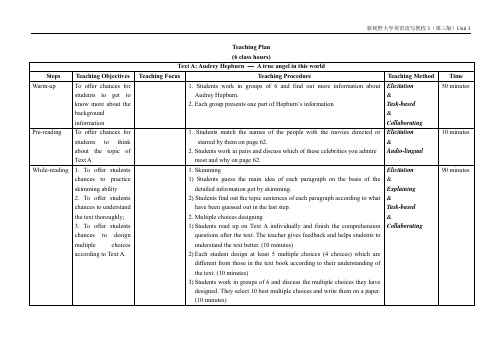
have been guessed out in the last step. 2. Multiple choices designing 1) Students read up on Text A individually and finish the comprehension
Using signal words properly
4) Every two groups exchange the multiple choices they have designed. Students in groups work together and finish the 10 multiple choices the other group has designed. (8 minute)
2. Students work in pairs and discuss which of these celebrities you admire most and why on page 62.
1. Skimming 1) Students guess the main idea of each paragraph on the basis of the
Language points: Vocabulary: ①Words for reading: Students work in pairs and read the text again to
underline a maximum of six words or phrases they don’t understand. Once chosen students show their words/phrases to their partner to see whether they can help in guessing meanings out. Finally, they are allowed to look up their words in the dictionaries and record both the words and the meanings. ②Exercises: Language focus ③Quiz: old to new 1. The teacher checks the writing work of students before giving feedback 2. The teacher concludes and provides feedback in general 3. Students check by themselves according to the feedback and make self-evaluation 4. Students check works of their peers according to the feedback and make evaluation
新视野大学英语读写教程第三版电子教案Book1Unit1
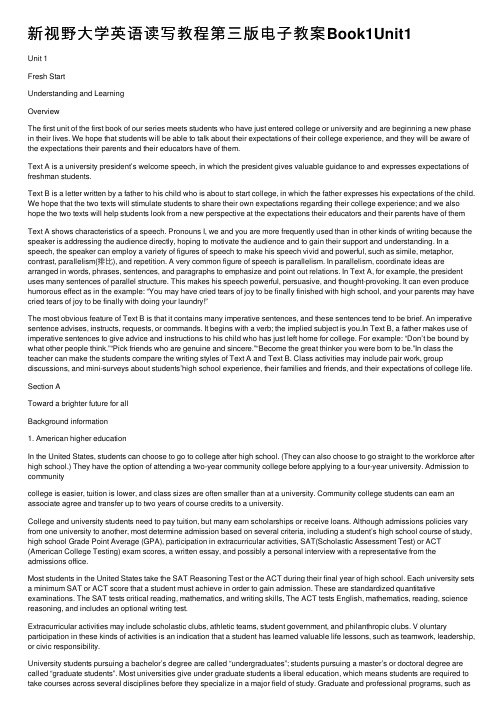
新视野⼤学英语读写教程第三版电⼦教案Book1Unit1Unit 1Fresh StartUnderstanding and LearningOverviewThe first unit of the first book of our series meets students who have just entered college or university and are beginning a new phase in their lives. We hope that students will be able to talk about their expectations of their college experience, and they will be aware of the expectations their parents and their educators have of them.Text A is a university president’s welcome speech, in which the president gives valuable guidance to and expresses expectations of freshman students.Text B is a letter written by a father to his child who is about to start college, in which the father expresses his expectations of the child. We hope that the two texts will stimulate students to share their own expectations regarding their college experience; and we also hope the two texts will help students look from a new perspective at the expectations their educators and their parents have of them Text A shows characteristics of a speech. Pronouns I, we and you are more frequently used than in other kinds of writing because the speaker is addressing the audience directly, hoping to motivate the audience and to gain their support and understanding. In a speech, the speaker can employ a variety of figures of speech to make his speech vivid and powerful, such as simile, metaphor, contrast, parallelism(排⽐), and repetition. A very common figure of speech is parallelism. In parallelism, coordinate ideas are arranged in words, phrases, sentences, and paragraphs to emphasize and point out relations. In Text A, for example, the president uses many sentences of parallel structure. This makes his speech powerful, persuasive, and thought-provoking. It can even produce humorous effect as in the example: “You may have cried tears of joy to be finally finished with high school, and your parents may have cried tears of joy to be finally with doing your laundry!”The most obvious feature of Text B is that it contains many imperative sentences, and these sentences tend to be brief. An imperative sentence advises, instructs, requests, or commands. It begins with a verb; the implied subject is you.In Text B, a father makes use of imperative sentences to give advice and instructions to his child who has just left home for college. For example: “Don’t be bound by what other people think.”“Pick friends who are genuine and sincere.”“Become the great thinker you were born to be.”In class the teacher can make the students compare the writing styles of Text A and Text B. Class activities may include pair work, group discussions, and mini-surveys about students’high school experience, their families and friends, and their expectations of college life. Section AToward a brighter future for allBackground information1. American higher educationIn the United States, students can choose to go to college after high school. (They can also choose to go straight to the workforce after high school.) They have the option of attending a two-year community college before applying to a four-year university. Admission to communitycollege is easier, tuition is lower, and class sizes are often smaller than at a university. Community college students can earn an associate agree and transfer up to two years of course credits to a university.College and university students need to pay tuition, but many earn scholarships or receive loans. Although admissions policies vary from one university to another, most determine admission based on several criteria, including a student’s high school course of study, high school Grade Point Average (GPA), participation in extracurricular activities, SAT(Scholastic Assessment Test) or ACT (American College Testing) exam scores, a written essay, and possibly a personal interview with a representative from the admissions office.Most students in the United States take the SAT Reasoning Test or the ACT during their final year of high school. Each university sets a minimum SAT or ACT score that a student must achieve in order to gain admission. These are standardized quantitative examinations. The SAT tests critical reading, mathematics, and writing skills, The ACT tests English, mathematics, reading, science reasoning, and includes an optional writing test.Extracurricular activities may include scholastic clubs, athletic teams, student government, and philanthropic clubs. V oluntary participation in these kinds of activities is an indication that a student has learned valuable life lessons, such as teamwork, leadership, or civic responsibility.University students pursuing a bachelor’s degree are called “undergraduates”; students pursuing a master’s or doctoral degree are called “graduate students”. Most universities give under graduate students a liberal education, which means students are required to take courses across several disciplines before they specialize in a major field of study. Graduate and professional programs, such asmedicine or law, are specialized. All degree programs require students to complete a minimum number of credit hours before graduating.Selection for admission to a graduate program is based on several criteria. These include completion of a bachelor’s degree, the student’s undergraduate coursework and GPA. Students are also expected to write an essay as part of their application or to submit a writing sample. Most master’s programs require students to have a minimum score on the Graduate Record Examination (GRE), which tests verbal reasoning, quantitative reasoning, critical thinking, and analytical writing skills.Students continue to take course at the graduate level. A final thesis is required for most master’s programs. Doctoral students take course until they have earned enough credit hours to attempt their qualifying examinations. These are usually taken over several days and often include a written and oral component. After doctoral students pass their qualifying exams, they are advanced to candidacy and can begin writing their dissertation. Before the degree is given, the completed dissertation must be orally defended before the candidate’s faculty committee.2. Vera WangVera Wang is a Chinese-American fashion designer. She was born and raised in New York City. While trained as a figure skater in high school, she eventually earned a degree in art history from Sarah Lawrence College in 1971. But a career in fashion was her dream. She worked as a senior fashion editor for Vogue magazine for 15 years. In 1985, she left vogue and joined Ralph Lauren as a design director for two years. In 1990, she opened her own design salon in New York, and featured her trademark bridal gowns. Wang has made wedding gowns for many celebrities and public figures, such as Jennifer Lopez (詹尼佛·洛佩兹), Sharon Stone (莎朗·斯通) and Chelsea Clinton (切尔西·克林顿).Detailed study of the text1. Your achievement is the triumph of years of hard work, both of your own and of your parents and teachers. (Para. 1)Meaning: Your entering this university is an important success. This success is due to many years of your hard work, and many years of your parents’ and teachers’ hard work.★triumph: n. [C] an important victory or success after a difficult struggle (尤指苦战后获得的)胜利,成功,成就Winning the championship was a great personal triumph for this young tennis player.赢得冠军对这个年轻的⽹球运动员来说是很⼤的个⼈成就。
新视野大学英语第三册读写教程PPt-B3-U1-A.

31
Notes to the Text—Focus Study
5. Just as my father’s death had changed world overnight, September 11th changed our lives; the world we’d known was gone. (L65)
Jimmy’s Mother Jimmy’s Mother taught Jimmy practical things like how to brush his teeth or put on a belt.
31
Text Study—Understanding
Jimmy’s Father
He and Jimmy were inseparable. They ate breakfast together and on weekdays drove off to the navy shipping center every morning where they both worked.
“just as” = “in the way that someone says, or in the same condition something is in” .
e.g. Just as we gained fame in victory, we lost nothing in defeat.
I was ... outsi
who picked on my brother
Chinese Version
tell on sb.
新视野大学英语第三版读写教程book2-unit7教案
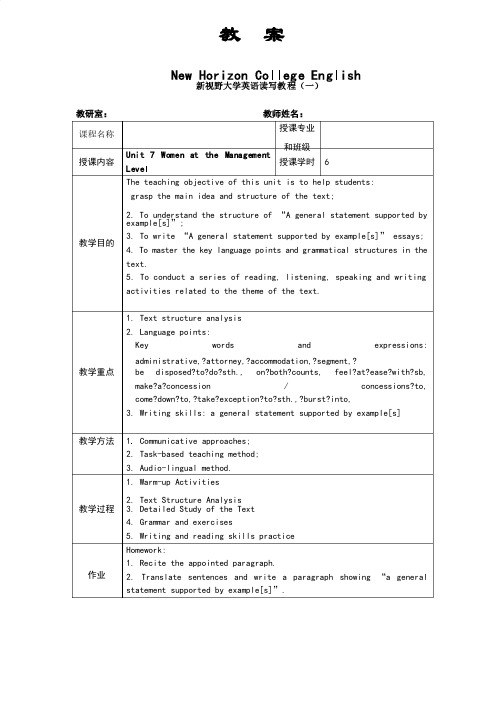
教 案案New Horizon College English 新视野大学英语读写教程(一)教研室: 教师姓名: 课程名称课程名称授课专业和班级 授课内容 Unit 7 Women Women at at the Management Level授课学时 6 教学目的 The teaching objective of this unit is to help students:grasp the main idea and structure of the text;2. To understand the structure of 2. To understand the structure of ““A general statement supported by example[s]example[s]”;”;3. To write 3. To write ““A general statement supported by example[s]A general statement supported by example[s]”” essays;4. To master the key language points and grammatical structures in the text.5. To conduct a series of reading, listening, speaking and writing activities related to the theme of the text.教学重点 1. Text structure analysis2. Language points:Key words and expressions: administrative,?attorney,?accommodation,?segment,?be disposed?to?do?sth., on?both?counts, feel?at?ease?with?sb, make?a?concession / concessions?to, come?down?to,?take?exception?to?sth.,?burst?into,3. Writing skills: a general statement supported by example[s] 教学方法 1. Communicative approaches;2. Task-based teaching method;3. Audio-lingual method.教学过程 1. Warm-up Activities2. Text Structure Analysis3. Detailed Study of the Text4. Grammar and exercises5. Writing and reading skills practice作业 Homework:1. Recite the appointed paragraph.2. Translate sentences and write a paragraph showing “a generalstatement supported by example[s]statement supported by example[s]””.辅助手段 Multimedia software 辅导答疑教学内容Ⅰ. Warm-up activities Step 1 GreetingsGreet the whole class as usual.Step 2. Review1. Ask students some questions to review the last lesson (show them on the screen screen)).2. Check the homeworkMethod: Talk in groups; Use task-based language teaching method, communicative approach, and audio-lingual method.Step 3. Lead-in and preparation for readingShow the Ss some pictures and let them talk to each other about the topic on the screen.1. What is career woman?2. Should women stay home or work outside? Why?3. What are the advantages and disadvantages for the career woman?Purpose: Arouse the students’ interest of study. Bring in new subject: Genetic EngineeringStep 4. Fast readingAsk the Ss to read the passage as quickly as they can and to answer the questions on thescreen. Let them get the main idea of each paragraph and make clear about the text structure. Ⅱ. Text Structure AnalysisPurpose : : Improve the students’ reading and writing ability and understand the Improve the students’ reading and writing ability and understand the general idea of each paragraph.Method : Read the text individually and talk in groups; Use task-based language teaching method, reading approach, communicative approach and total physical response methodPart I (paras. 1-2): Introduction (thesis statement) of the textPart II (paras. 3): How female bosses managePart III (paras. 4-5): How male and female bosses are different in working styles Part IV(paras. 6-8)?: Why male and female bosses manage differentlyPart V(paras. 9): Obstacles for female bossesPart VI(paras. 10): ConclusionⅢ. Detailed Studies of the TextWords and Phrases1. employeen.[C] sb. who is paid to work for sb. else 受雇者;雇员Knowing what an employer is looking for in a potential employee can help someone to prepare for an interview.了解雇主在寻找什么样的潜在雇员可以帮助人们准备面试。
- 1、下载文档前请自行甄别文档内容的完整性,平台不提供额外的编辑、内容补充、找答案等附加服务。
- 2、"仅部分预览"的文档,不可在线预览部分如存在完整性等问题,可反馈申请退款(可完整预览的文档不适用该条件!)。
- 3、如文档侵犯您的权益,请联系客服反馈,我们会尽快为您处理(人工客服工作时间:9:00-18:30)。
新视野大学英语读写教程(第三版)BOOK 3 教案UNIT 3Life stories___________________PART lUNDERSTANDING AND LEARNINGOverview________________________________________Movies play an important role in almost everyone’s life. People from the movie industry have considerable influence on the masses. They exhibit personality traits that deserve admiration and applause, and could be looked up to as role models. This unit will fully explore their best qualities.The two texts in the current unit are biographies, a genre of literature, which is a written account of another person’s life. Each of the texts narrates, analyzes and interprets the most important facts of one prominent figure in the movie domain. Text A pays attention to actress Audrey Hepburn’s noble endeavor and her contribution to the cause of UNICEF, while Text B portrays the determination and fervent spirit of director and producer Steven Spielberg.The teacher can make students do additional research at the library, or Audrey Hepburn and Steven Spielberg in advance. Then in the classroom, the teacher may organize a variety of activities including pair work, group discussion, andmini-survey to talk about the films or the issue of fame, fortune, and social responsibility.Section A_________________________________________________ Audrey Hepburn-A true angel in this world1 Audrey HepburnAudrey Hepburn (1929-1993) was a slender, stylish motion picture actress known for her radiant beauty, her ability to project an air of sophistication tempered by a charming innocence, and her tireless efforts to aid needy children.Although born in Belgium, Hepburn had British citizenship through her father and attended school in England as a child. In 1939, however, at the onset of World War II, her mothe r(Hepburn’s father left the family when she was six years old) moved the child to the Netherlands (where the author of this text mistakenly considered Hepburn was born), thinking the neutral country safer than England. Throughout World War II,Hepburn endured hardships in Nazi-occupied Holland. She still managed, however, to attend school and take ballet lessons. After the war, she continued to study ballet in Amsterdam and in London. During her early 20s, she studied acting and worked as a model and dancer. After appearing in several British films and starring in the 1951 Broadway play Gigi (《琪琪》), Hepburn gained instant Hollywood stardom for playing the Academy Award-winning lead role in Roman Holiday. She remains one of few entertainers who have won Academy, Emmy, Grammy, and Tony Awards.Hepburn’s war-time struggles inspired her passion for humanitarian work. She devoted much of her later life to UNICEF, visiting famine-stricken villages, in Latin America, Africa, until shortly before her death of cancer in 1993. She was awarded the Presidential Medal of Freedom in recognition of her work as a UNICEF Goodwill Ambassador in 1992.2 UNICEFUNICEF (United Nations International Children’s Emergency Fund) was created by the United Nations General Assembly on December 11, 1946, to provide emergency food and healthcare tochildren in countries that had been devastated by World War II. After 1950 the fund directed its efforts toward general programs for the improvement of children’s welfare, particularly in less-developed countries and in various emergency situations. The organization’s broader mission was reflected in the name it adopted in 1953, the United Nations Children’s Fund, but it has continued to be known by the popular acronym based on this old name. Headquartered in New York City, UNICEF provides long-term humanitarian and developmental assistance to children and mothers in developing countries. UNICEF’s programs emphasize developing community-level services to promote the health and well-being of children.3 UNICEF Ambassador of GoodwillMany celebrities have acted as international, regional or national ambassadors, depending on their profile, interests, and desired level of responsibility. The role of Goodwill Ambassador allows celebrities with a demonstrated interest in UNICEF issues to use their fame to draw attention to important issues. This may take the form of public appearances and talks,visits to troubled regions, and use of their political access to advocate UNICEF causes, all of which have the power to draw attention from the media and to create public awareness.4 Gregory PeckGregory Peck (1916-2003) was one of the world’s most popular film stars from the 1940s to the 1960s. He is best known for his performance in the 1962 film To Kill a Mockingbird, which earned him the Academy Award for Best Actor.In 1967 Peck received the Academy’s Jean Hersholt Humanitarian Award. He was also in 1969 for his lifetime humanitarian effort. Always politically progressive, Peck was active in such causes as anti-war protests, workers’ rights and civil rights.5 Billy WilderBilly Wilder (1906-2002) was an Austrian-born American filmmaker, screenwriter, producer artist, and journalist. His career spanned more than 50 years and 60 films. He is regarded as one of the most brilliant and versatile filmmakers of Hollywood’s golden age. During his career, Wilder gained 20 Academy Award nominations and won six Oscars. He received alifetime achievement award from the American Film Institute in 1986.6 Academy AwardsAn Academy Award (byname Oscar) is an award presented annually by the American Academy of Motion Picture Arts and Science to recognize excellence of professionals in the film industry, including directors , actors , and writers. The award ceremony is one of the most prominent award ceremonies in the world, and is televised live in more than 200 countries annually.7 Hubert de GivenchyHubert de Givenchy (1927-,) is a French aristocrat and fashion designer who founder The House of Givenchy in 1952. He is famous for having designed much of the personal and professional wardrobe of Audrey Hepburn, as well as clothing for clients such as Jacqueline Kennedy. He was named to the International Best Dress List Hall of Fame in 1970.Detailed study of the text1 Audrey Hepburn thrilled audiences with starring roles innoteworthy films...Meaning: Audrey Hepburn played leading roles in many extraordinary films, and such poles gave great pleasure to the people who watched the films…★noteworthy: a. important or interesting enough to deserve your attention 值得注意的;显著的One of the most noteworthy trends in contemporary American higher education is the tendency among community colleges to offer certificate programs besides the traditional associate degrees.当代美国高等教育最显著的趋势之一就是社区大学除了授予传统的副学士学位,还开设学历课程。
